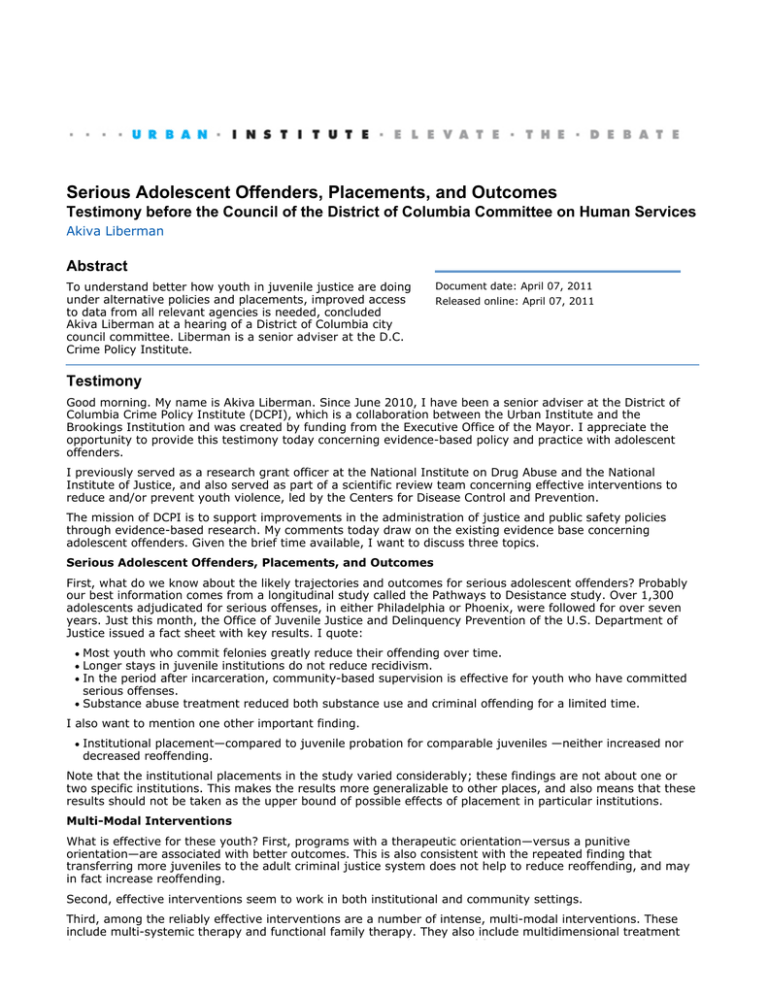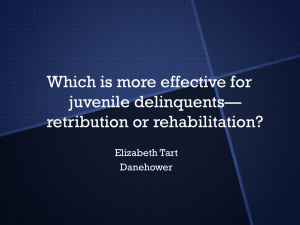Serious Adolescent Offenders, Placements, and Outcomes Abstract Akiva Liberman
advertisement

Serious Adolescent Offenders, Placements, and Outcomes Testimony before the Council of the District of Columbia Committee on Human Services Akiva Liberman Abstract To understand better how youth in juvenile justice are doing under alternative policies and placements, improved access to data from all relevant agencies is needed, concluded Akiva Liberman at a hearing of a District of Columbia city council committee. Liberman is a senior adviser at the D.C. Crime Policy Institute. Document date: April 07, 2011 Released online: April 07, 2011 Testimony Good morning. My name is Akiva Liberman. Since June 2010, I have been a senior adviser at the District of Columbia Crime Policy Institute (DCPI), which is a collaboration between the Urban Institute and the Brookings Institution and was created by funding from the Executive Office of the Mayor. I appreciate the opportunity to provide this testimony today concerning evidence-based policy and practice with adolescent offenders. I previously served as a research grant officer at the National Institute on Drug Abuse and the National Institute of Justice, and also served as part of a scientific review team concerning effective interventions to reduce and/or prevent youth violence, led by the Centers for Disease Control and Prevention. The mission of DCPI is to support improvements in the administration of justice and public safety policies through evidence-based research. My comments today draw on the existing evidence base concerning adolescent offenders. Given the brief time available, I want to discuss three topics. Serious Adolescent Offenders, Placements, and Outcomes First, what do we know about the likely trajectories and outcomes for serious adolescent offenders? Probably our best information comes from a longitudinal study called the Pathways to Desistance study. Over 1,300 adolescents adjudicated for serious offenses, in either Philadelphia or Phoenix, were followed for over seven years. Just this month, the Office of Juvenile Justice and Delinquency Prevention of the U.S. Department of Justice issued a fact sheet with key results. I quote: Most youth who commit felonies greatly reduce their offending over time. Longer stays in juvenile institutions do not reduce recidivism. In the period after incarceration, community-based supervision is effective for youth who have committed serious offenses. Substance abuse treatment reduced both substance use and criminal offending for a limited time. I also want to mention one other important finding. Institutional placement—compared to juvenile probation for comparable juveniles —neither increased nor decreased reoffending. Note that the institutional placements in the study varied considerably; these findings are not about one or two specific institutions. This makes the results more generalizable to other places, and also means that these results should not be taken as the upper bound of possible effects of placement in particular institutions. Multi-Modal Interventions What is effective for these youth? First, programs with a therapeutic orientation—versus a punitive orientation—are associated with better outcomes. This is also consistent with the repeated finding that transferring more juveniles to the adult criminal justice system does not help to reduce reoffending, and may in fact increase reoffending. Second, effective interventions seem to work in both institutional and community settings. Third, among the reliably effective interventions are a number of intense, multi-modal interventions. These include multi-systemic therapy and functional family therapy. They also include multidimensional treatment foster care, which is an intensive, structured, and supported program of foster care designed as an alternative foster care, which is an intensive, structured, and supported program of foster care designed as an alternative to congregate or institutional care. This should not be especially surprising, since we know that many serious youth in juvenile justice have risk factors in multiple domains, and compared with adults, adolescents are more influenced by family risk factors and peer risk factors. Fourth, not all adolescent offenders are the same. Adolescents need to be matched to interventions using structured risk and needs assessment tools. Findings Specific to the District of Columbia Finally, let me turn to what we know in particular about District youth in juvenile justice and how they are doing under various alternative policies and placements. I must report that we know too little. There is much work to be done. One research project of interest to DCPI concerns youth commitments to the Department of Youth Rehabilitation Services. Who is being committed? What happens to them? And what are their outcomes? DYRS has also expressed interest in our studying youth commitments, and we are working to finalize necessary arrangements for obtaining DYRS data, which we are excited to examine and analyze. However, DYRS data alone will be insufficient to fully describe or understand youth commitments. The youth committed to DYRS, after all, are only a subset of those who are arrested. Understanding youth commitment requires the ability to look at the broader set of all youth who might potentially be committed, and to track those youth through the data across agencies over time. Who is—and is not—diverted, adjudicated, given juvenile probation, and committed? How are youth bouncing among agencies, and to what effect? Studying such critical questions is hampered by data-sharing and confidentiality issues. Current arrangements may allow such data sharing for research purposes, but this is done only on a project-by-project basis after considerable negotiation. I believe that confidentiality concerns can be addressed most effectively and efficiently by giving an independent research organization, such as DCPI, routine access to identifiable individual-level data from all involved agencies. The results of analyzing such data would only be reported in the aggregate. Of course, statutory restrictions would apply concerning the sharing of individual data and concerning limits to data sharing for operational purposes. Such a structure would allow analyses of how the juvenile justice system functions as a whole, and would greatly inform juvenile justice policymaking in the District. Akiva Liberman has been a senior adviser at the D. C. Crime Policy Institute since June 2010. He is also a senior fellow in the Justice Policy Center of the Urban Institute. From 2007 to 2010, he served at the National Institute of Drug Abuse as a grant officer for research concerning the implementation of effective services for drug abusing offenders. From 1999 to 2007, at the National Institute of Justice, he served as a grant officer for research on juvenile delinquency and juvenile justice. He was also part of a scientific team led by the Center for Disease Control and Prevention for the Task Force on Community Prevention that published systematic reviews concerning effective interventions to reduce and/or prevent youth violence. References Mulvey, E. P. 2011. “Highlights from Pathways to Desistance. A Longitudinal Study of Serious Adolescent Offenders.” Washington, DC: Office of Juvenile Justice and Delinquency Prevention, U.S. Department of Justice. Lipsey, M. W. 2009. “The Primary Factors that Characterize Effective Interventions with Juvenile Offenders: A Meta-Analytic Overview.” Victims and Offenders 4: 124–47. Aos, S., P. Phillips, R. Barnoski, and R. Lieb. 2001. “The Comparative Costs and Benefits of Programs to Reduce Crime.” Version 4.0. Washington State Institute for Public Policy. Hahn, R., A. McGowan, A. Liberman, A. Crosby, M. Fullilove, R. Johnson, E. Moscicki, L. Price, S. Snyder, F. Tuma, J. Lowy, P. Briss, S. Cory, and G. Stone. 2007. “Effects on Violence of Laws and Policies Facilitating the Transfer of Youth from the Juvenile to the Adult Justice System: A Report on Recommendations of the Task Force on Community Preventive Services.” Morbidity and Mortality Weekly Report Recommendations and Reports, 2007 Nov 30, 56(RR09), 1-11. Other Publications by the Authors Akiva Liberman Usage and reprints: Most publications may be downloaded free of charge from the web site and may be used and copies made for research, academic, policy or other non-commercial purposes. Proper attribution is required. Posting UI research papers on other websites is permitted subject to prior approval from the Urban Institute—contact publicaffairs@urban.org. If you are unable to access or print the PDF document please contact us or call the Publications Office at (202) 261-5687. Disclaimer: The nonpartisan Urban Institute publishes studies, reports, and books on timely topics worthy of public consideration. The views expressed are those of the authors and should not be attributed to the Urban Institute, its trustees, or its funders. Copyright of the written materials contained within the Urban Institute website is owned or controlled by the Urban Institute. Source: The Urban Institute, © 2012 | http://www.urban.org

